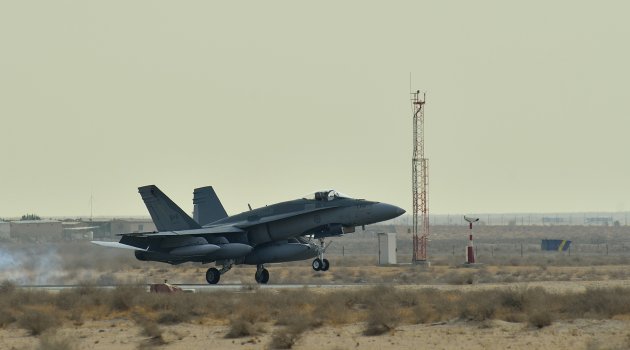KUWAIT
CITY - Canadian warplanes have flown their first operational flights,
but have yet to carry out strike missions against Islamic State targets.
Six
CF-18 jet fighters, two CP-140 Aurora surveillance planes and a C-150
refuelling jet are operating out of undisclosed airfields in Kuwait and
will launch bombing missions against the forces of the Islamic State of
Iraq and the Levant soon."Operational flights have begun," said a senior defence source. "No bombs have been dropped, but ops are indeed underway."
The source would not reveal when the missions were conducted and what sort of tasks the fighters carried out, whether it was training or combat air patrols, or if the Auroras have started to carry out surveillance of potential ISIL targets.
Word of the missions comes from a series of defence sources because the Canadian military has not allowed media access to the airfields, citing security concerns of their Kuwaiti hosts.
The aircraft receive their strike orders and targets from the U.S.-led coalition and join aircraft from a number of different countries, including the U.S., Britain, Australia and several Gulf States.
The jets will be bombing military targets, such as command centres, vehicles and artillery, most of which is U.S-made hardware that Islamic State fighters seized from fleeing Iraqi army forces earlier this summer.
A number of fresh reports are circulating that coalition jets could face an increased anti-aircraft threat as Islamic State fighters are now apparently armed with sophisticated shoulder-launched missiles.
U.S. officials, speaking on background to the New York Times earlier this week, described the appearance of the Chinese-made FN-6 heat-seeking missiles as "game changers." It is believed the weapons were originally provided to moderate Syrian rebels by Qatar and possibly Saudi Arabia, according to the report.
The missiles are a major threat to low-flying aircraft, such as attack helicopters. ISIL reportedly shot down an Iraqi Army Apache gunship using the weapons.
Prior to the beginning of the campaign, Canadian military commanders acknowledged the anti-aircraft threat, but noted that both the CF-18s and the Auroras can fly higher than the effective range of the missiles, known as Manpads.
A bigger concern, according to defence experts, is that Islamic State fighters might get their hands on an SA-24, the latest generation of Russia-made anti-aircraft weapons. The Iraqi government recently acquired such a system and those missiles have a longer range and the ability to manoeuvre in a more nimble fashion to avoid the counter-measures of its target.
The Canadian contribution to the air campaign is mandated to last six months, but is likely to be extended.
The operations are being carried out under a blanket of secrecy as western bases, embassies and institutions throughout the Gulf region remains on heightened security alert for possible retaliation by Islamic State supporters.
George E. Irani, a professor at the American University of Kuwait, said the school circulated a memo on Wednesday warning of threats and urging vigilance.
A
jidahist website, earlier this week, urged supporters to attack western
schools, specifically teachers, but U.S. officials say no direct threat
has been uncovered thus far.

No comments:
Post a Comment